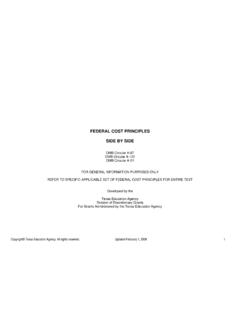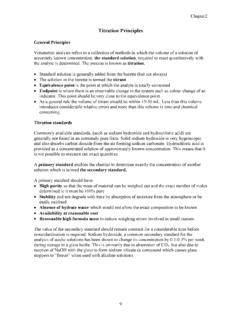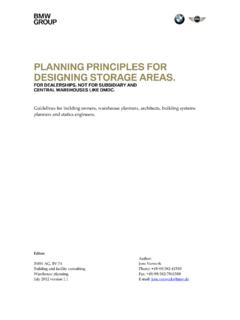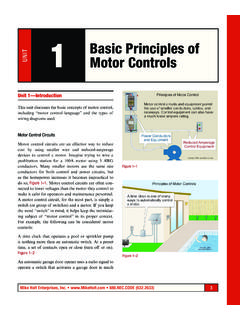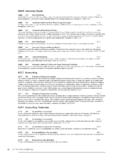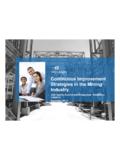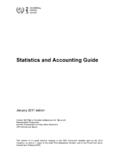Transcription of www.uwcc.wisc.edu
1 , .-PrefaceThis guide has been designed to present the very basics in bookkeeping and coopera-tive financial statements. The format is designed for those that have limited bookkeep-ing or accounting experience. It is not meant to be all inclusive, but to provide guid-ance in developing the cooperative s record keeping system and understandingfinancial most cooperatives, trained accountants will take care of the financial reports andmore difficult accounts, such as depreciation expense. However, all board membersshould understand the bookkeeping functions and be able to interpret financial understanding all components of bookkeeping and the financial documents, theboard will be better able to design an accounting system for their cooperative, maintainaccurate bookkeeping records, and make prudent business decisions based on thefinancial exercises are included that should be completed after the sections on thedaily journal and the general ledger and a final exercise at the end of the 1998 Price.
2 Foreign-$ ~~ Accounting Balance Income of Cash Cash Flow Transactions in the Daily Amounts - As Debits and Debits from entries in the General , Description, and Dollar ~ Capital Accounts One-The Daily Two - The General 2 Exercise One - The Daily Two - The General 1..111 Understanding Cooperative Bookkeepingand Financial StatementsR. Wade BinionAgricultural EconomistFinancial reports are used to evaluate past opera-tions and are the basis for management and operatingdecisions on future projects. The board of directors usethe reports for feedback on the financial status of thecooperative, to evaluate progress and to makeinformed decisions about future operations.
3 Managersneed accurate and timely information to run the day-to-day operations. Creditors examine the financialreports when considering loans to the cooperative andaccountants need accurate records to prepare tax and current records are also importantto members of the cooperative. Records should showthe net profit, the level of each member s patronageaccount and the amount of equity members hold in thecooperative. This facilitates distribution of patronagerefunds and ensures that the cooperative is operatingaccording to cooperative ACCOUNTING SYSTEMThe cooperative s accounting system is a methodof recording and reporting the financial results of itsbusiness transactions.
4 The bookkeeper records thebusiness transactions of the cooperative in a daily jour-nal. These records are then used to generate variousfinancial reports that provide an historical record ofthe cooperatives s business accounting system is discussed in two sec-tions in this guide. The first covers the balance sheet,income statement, and statement of cash flows. Thesefinancial statements report the results of the coopera-tive s business transactions. This section also explainsthe monthly cash flow statement, a planning tool formanagement. Section 2 covers the record keeping func-tions of the daily journal and general ledger. Section 2also covers the member records that are neededbecause of the cooperative s unique role of providingeconomic benefits distributed in proportion to eachmember s REPORTINGT hree financial reports commonly used in busi-ness are the balance sheet, income statement, and thestatement of cash flows.
5 They report the financial posi-tion of the cooperative, its performance over a giventime period, and its ability to meet cash are the basis for planning future operations. Eachreport contains different, but interrelated informationthat together give a complete picture of the financialoperations of the cooperative. Managers, bookkeepersand board members should be able to understand andinterpret these reports so they can make informedbusiness decisions about the future of the I-The COOperah? Accounting SystemFinancial ReportingA. Balance SheetB. Income StatementC. Statement of Cash FlowsD. Monthly Cash Flow StatementBookkeepingA. Daily JournalB. General LedgerC.
6 Member Records1 Capital Investment2. Patronage Accounts1 THE BALANCE SHEETTHE INCOME STATEMENTThe balance sheet is used to report the financialposition of the cooperative at a given point in time,usually at the end of a month, quarter, or year. As seenin Exhibit 2, it shows the assets owned by the coopera-tive balanced against its liabilities and member are listed on the left-hand side of a balancesheet while liabilities and member equity are listed onthe right-hand side. Total assets, or resources ownedby the cooperative, must always equal the total liabili-ties and equity, or obligations of the = Liabilities + EquityAssets:Resources owned by the cooperativeLiabilities:Debts owed by the cooperativeEquity:Member s interest in the cooperativeAssets are shown as current assets and fixedassets.
7 Current assets include cash and those assetsthat are expected to be converted into cash within oneyear, such as saleable inventory and accounts receiv-able. Fixed assets are items the cooperative will useduring normal operations, such as buildings, machin-ery, and are shown in two categories-currentor long-term. Current liabilities are those paid within 1year such as accounts payable, short-term operatingloans, or the current portion of long-term loans. Thosedue beyond the next 12 months, such as mortgages,are long-term equity section of the balance sheet shows theamount of capital the members have invested in thecooperative through stock purchases, allocatedreserves, and per-unit 2-Balance SheetCooperative Balance Sheet as of December 31 AssetsCurrent:CashAccounts ReceivableInventoryLiabilitiesCurrent:Ac counts PayableLong-term: LoansFixed:BuildingsEquipmentMember EquityStockRetained EarningsThe income statement reports the results of allbusiness transactions of the cooperative that occurredduring a certain time period, such as month, quarter oryear.
8 It shows the total dollar revenue of the coopera-tive, the total expenses, and the resulting net income(or loss).Revenue is the dollar amount earned by thecooperative from operations. It can come from severalsources, such as selling merchandise in a supply coop-erative, charging members for services or marketingtheir products. In multi-functional cooperatives it isuseful to separate the revenue from each function onthe income example, Exhibit 3 shows the cooperative stotal bulk fertilizer sales of $60,000 on the incomestatement separately from the $10,000 service revenuefrom the spreading on the income statement that the cost ofgoods sold in the amount of $35,000 is subtracted fromfertilizer sales, resulting in a gross margin amount of$25, of goods sold is the amount the cooperativepaid its supplier for the fertilizer.
9 The gross margin of$25,000 is the cooperative s profit from selling the fer-tilizer. Because spreading fertilizer is a service thecooperative provides, there is no cost of goods sold tosubtract from this entire $10,000 service revenue from thespreading function (Exhibit 3) is added to the $25,000gross margin from fertilizer sales for a total gross rev-enue of $35, revenue is the total profit the cooperativereceived from providing goods and services to mem-bers that can be used for business are the costs incurred to provide ser-vices to members. They vary according to the industry,services provided, and structure of the should be categorized to determine the costsincurred to operate each phase of the 3 shows administrative, operating, inter-est, depreciation, and miscellaneous expense costs include the salaries of salesstaff, management, and office personnel.
10 Others areoffice supplies, insurance, accountant fees, and adver-tising. These expenses are not directly linked to opera-tions, but are the support services it provides. Someare considered fixed costs of operations because theydo not vary with the level of Year Ending December 31 Revenue:Fertilizer Sales- cost of Goods SoldL_$60,00035,000= Gross Margins25,000+ Service Revenue10,000down the cost of machinery or equipment over theuseful life of the item and is usually included on theincome statement at the end of each fiscal total expenses from gross revenuegives the net income (or loss) of the cooperative overthe given period of time. The year-end income state-ment should note the portion of net income distributedto members as cash patronage refunds and the portionthat remains as allocated Net Revenue35,000 STATEMENT OF CASH FLOWSE xpenses:AdministrativeOperatingDepreciat ionInterestMiscellaneous8,00011,0003,000 1,5002,000 Total Expenses25,500 Income Before Taxes9,500 Income Taxes1,000 Net Income (Loss)$8,500 Patronage Refunds.

